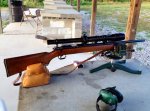In the Houston Warehouse Experiments the rifles were allowed to free recoil since free recoil was considered more consistent than trying to apply the exact shoulder force for every shot.
I assume a shoulder force is used in some bench rest shooting to prevent the rifle from recoiling off its support.
However, for 22LR bench rest shooting I assume the recoil would not be sufficient to de-support the rifle, at least if rifle weighed, say 7 or more pounds.
Thus, would not accuracy testing of 22LR ammunition be best done with free recoil?
I assume a shoulder force is used in some bench rest shooting to prevent the rifle from recoiling off its support.
However, for 22LR bench rest shooting I assume the recoil would not be sufficient to de-support the rifle, at least if rifle weighed, say 7 or more pounds.
Thus, would not accuracy testing of 22LR ammunition be best done with free recoil?



